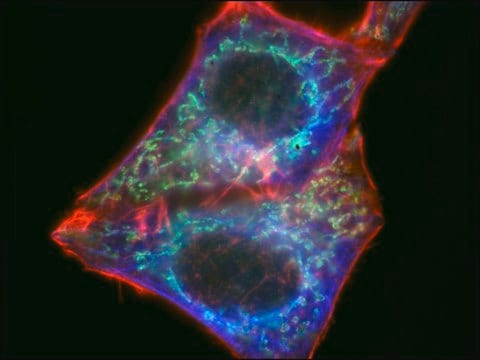추천 제품
생물학적 소스
mouse
Quality Level
결합
unconjugated
항체 형태
purified from hybridoma cell culture
항체 생산 유형
primary antibodies
클론
DX 54.10, monoclonal
양식
buffered aqueous solution
분자량
antigen ~175 kDa
종 반응성
human, mouse
농도
~1.5 mg/mL
기술
immunocytochemistry: suitable
immunoprecipitation (IP): suitable
microarray: suitable
western blot: 0.5-1 μg/mL using total cell extract of human osteogenic sarcoma
동형
IgG1
UniProt 수납 번호
배송 상태
dry ice
저장 온도
−20°C
타겟 번역 후 변형
unmodified
유전자 정보
human ... TP53BP2(7159)
mouse ... Trp53bp2(209456)
일반 설명
Monoclonal Anti-ASPP2 (mouse IgG1 isotype) is derived from the hybridoma DX 54.10 produced by the fusion of mouse myeloma cells (SP2/0 cells) and splenocytes from BALB/c mice. Apoptosis-stimulating protein of p53 (ASPP) family of proteins contains three members, ASPP1, ASPP2 and iASPP, which interact via their C-terminal region with p53 and modulate its activity.
특이성
Monoclonal Anti-ASPP2 recognizes human and mouse ASPP2. The epitope recognized by the antibody resides within amino acids 691-1128 of human ASPP2.
면역원
fragment of human ASPP2 (amino acids 691-1128).
애플리케이션
Mouse Monoclonal Anti-ASPP2 has been used for immunofluorescence analysis. The antibody can also be used for immunocytochemistry, immunoprecipitation and microarray applications.
Western blot analysis of Hek293 or 3T3-L1 adipocyte cell lysates was performed using monoclonal mouse anti-ASPP2 as the primary.
생화학적/생리학적 작용
ASPP2 is a tumor suppressor that activates p53. ASPP2 also regulates Par-3 which subsequently modulates the proliferation and polarity of neural progenitor cells during CNS development. Furthermore, ASPP2 interacts with active Ras to induce p53 mediated cell death. ASPP2 is known to function as a biomarker for invasive pituitary adenomas.
Apoptosis-stimulating protein of p53 (ASPP2) enhances the ability of p53 to induce apoptosis ASPP1 and ASPP2 stimulates the transactivation function of p63 and p73 on promoters of different genes such as BCL2 associated X, apoptosis regulator (Bax), p53-inducible gene 3 (PIG3) and p53 upregulated modulator of apoptosis (PUMA), but not mouse double minute 2 homolog (Mdm2) or p21WAF-1/CIP1.
물리적 형태
Solution in 0.01 M phosphate buffered saline, pH 7.4, containing 15 mM sodium azide.
면책조항
Unless otherwise stated in our catalog or other company documentation accompanying the product(s), our products are intended for research use only and are not to be used for any other purpose, which includes but is not limited to, unauthorized commercial uses, in vitro diagnostic uses, ex vivo or in vivo therapeutic uses or any type of consumption or application to humans or animals.
적합한 제품을 찾을 수 없으신가요?
당사의 제품 선택기 도구.을(를) 시도해 보세요.
Storage Class Code
10 - Combustible liquids
WGK
WGK 3
Flash Point (°F)
Not applicable
Flash Point (°C)
Not applicable
개인 보호 장비
Eyeshields, Gloves, multi-purpose combination respirator cartridge (US)
가장 최신 버전 중 하나를 선택하세요:
Lin Ma et al.
Oncology letters, 6(5), 1313-1318 (2013-11-02)
Nucleostemin is a GTP-conjugated protein located in the nucleoli of stem cells and certain cancer cells, and maintains cellular self-renewal. The present study aimed to evaluate nucleostemin as a potential target for pituitary adenoma gene therapy by investigating nucleostemin and
ASPP1 and ASPP2 are new transcriptional targets of E2F
Fogal V, et al.
Cell Death and Differentiation, 12(4), 369-369 (2005)
ASPP proteins specifically stimulate the apoptotic function of p53
Samuels-Lev Y, et al.
Molecular Cell, 8(4), 781-794 (2001)
Wei-Tzu Sun et al.
Biochemical and biophysical research communications, 376(2), 395-398 (2008-09-17)
The p53 tumor suppressor functions in maintaining the integrity of the genome. We have previously reported that DDA3 is an oncoprotein transcriptionally regulated by p53. To explore mechanisms underlying DDA3 action, we searched for its interacting proteins by yeast two-hybrid
Roberta Sottocornola et al.
Developmental cell, 19(1), 126-137 (2010-07-14)
Cell polarity plays a key role in the development of the central nervous system (CNS). Interestingly, disruption of cell polarity is seen in many cancers. ASPP2 is a haplo-insufficient tumor suppressor and an activator of the p53 family. In this
자사의 과학자팀은 생명 과학, 재료 과학, 화학 합성, 크로마토그래피, 분석 및 기타 많은 영역을 포함한 모든 과학 분야에 경험이 있습니다..
고객지원팀으로 연락바랍니다.








